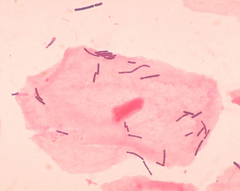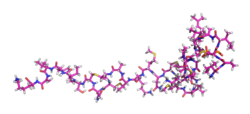
Biopreservation
Encyclopedia


Microbiota (disambiguation)
Microbiota is a genus of coniferous plants in the family Cupressaceae.Microbiota also refers to microflora and microfauna in an ecosystem . Also, can be used to refer to life outside a host such as life found in a soil sample....
or antimicrobial
Antimicrobial
An anti-microbial is a substance that kills or inhibits the growth of microorganisms such as bacteria, fungi, or protozoans. Antimicrobial drugs either kill microbes or prevent the growth of microbes...
s as a way of preserving food
Food preservation
Food preservation is the process of treating and handling food to stop or slow down spoilage and thus allow for longer storage....
and extending its shelf life
Shelf life
Shelf life is the length of time that food, drink, medicine, chemicals, and many other perishable items are given before they are considered unsuitable for sale, use, or consumption...
. Beneficial bacteria or the fermentation
Fermentation (biochemistry)
Fermentation is the process of extracting energy from the oxidation of organic compounds, such as carbohydrates, using an endogenous electron acceptor, which is usually an organic compound. In contrast, respiration is where electrons are donated to an exogenous electron acceptor, such as oxygen,...
products produced by these bacteria are used in biopreservation to control spoilage and render pathogen
Pathogen
A pathogen gignomai "I give birth to") or infectious agent — colloquially, a germ — is a microbe or microorganism such as a virus, bacterium, prion, or fungus that causes disease in its animal or plant host...
s inactive in food. It is a benign ecological approach which is gaining increasing attention.
Of special interest are lactic acid bacteria
Lactic acid bacteria
The lactic acid bacteria comprise a clade of Gram-positive, low-GC, acid-tolerant, generally non-sporulating, non-respiring rod or cocci that are associated by their common metabolic and physiological characteristics. These bacteria, usually found in decomposing plants and lactic products, produce...
(LAB). Lactic acid bacteria have antagonistic properties which make them particularly useful as biopreservatives. When LABs compete for nutrients, their metabolite
Metabolite
Metabolites are the intermediates and products of metabolism. The term metabolite is usually restricted to small molecules. A primary metabolite is directly involved in normal growth, development, and reproduction. Alcohol is an example of a primary metabolite produced in large-scale by industrial...
s often include active antimicrobials such as lactic and acetic acid, hydrogen peroxide, and peptide
Peptide
Peptides are short polymers of amino acid monomers linked by peptide bonds. They are distinguished from proteins on the basis of size, typically containing less than 50 monomer units. The shortest peptides are dipeptides, consisting of two amino acids joined by a single peptide bond...
bacteriocin
Bacteriocin
Bacteriocins are proteinaceous toxins produced by bacteria to inhibit the growth of similar or closely related bacterial strain. They are typically considered to be narrow spectrum antibiotics, though this has been debated...
s. Some LABs produce the antimicrobial nisin
Nisin
Nisin is a polycyclic antibacterial peptide with 34 amino acid residues used as a food preservative. It contains the uncommon amino acids lanthionine , methyllanthionine , didehydroalanine and didehydroaminobutyric acid . These unusual amino acids are introduced by posttranslational modification...
which is a particularly effective preservative.
A bacterium that is a suitable candidate for use as a biopreservative does not necessarily have to ferment the food. But if conditions are suitable for microbial growth, then a biopreservative bacterium will compete well for nutrients with the spoilage and pathogenic bacteria in the food. As a product of its metabolism, it should also produce acids and other antimicrobial agents, particularly bacteriocins. Biopreservative bacteria, such as lactic acid bacteria, must be harmless to humans.
These days LAB bacteriocins are used as an integral part of hurdle technology
Hurdle technology
Hurdle technology is a method of ensuring that pathogens in food products can be eliminated or controlled. This means the food products will be safe for consumption, and their shelf life will be extended. Hurdle technology usually works by combining more than one approach. These approaches can be...
. Using them in combination with other preservative techniques can effectively control spoilage bacteria and other pathogens, and can inhibit the activities of a wide spectrum of organisms, including inherently resistant Gram-negative bacteria."
In fish processing
Fish processing
The term fish processing refers to the processes associated with fish and fish products between the time fish are caught or harvested, and the time the final product is delivered to the customer...
, biopreservation is achieved by adding antimicrobial
Antimicrobial
An anti-microbial is a substance that kills or inhibits the growth of microorganisms such as bacteria, fungi, or protozoans. Antimicrobial drugs either kill microbes or prevent the growth of microbes...
s or by increasing the acidity of the fish muscle. Most bacteria stop multiplying when the pH
PH
In chemistry, pH is a measure of the acidity or basicity of an aqueous solution. Pure water is said to be neutral, with a pH close to 7.0 at . Solutions with a pH less than 7 are said to be acidic and solutions with a pH greater than 7 are basic or alkaline...
is less than 4.5. Traditionally, acidity has been increased by fermentation
Fermentation (food)
Fermentation in food processing typically is the conversion of carbohydrates to alcohols and carbon dioxide or organic acids using yeasts, bacteria, or a combination thereof, under anaerobic conditions. Fermentation in simple terms is the chemical conversion of sugars into ethanol...
, marination
Marination
Marination is the process of soaking foods in a seasoned, often acidic, liquid before cooking. The origins of the word allude to the use of brine in the pickling process, which led to the technique of adding flavor by immersion in liquid...
or by directly adding acetic, citric or lactic acid to food products. Other preservatives include nitrite
Nitrite
The nitrite ion has the chemical formula NO2−. The anion is symmetric with equal N-O bond lengths and a O-N-O bond angle of ca. 120°. On protonation the unstable weak acid nitrous acid is produced. Nitrite can be oxidised or reduced, with product somewhat dependent on the oxidizing/reducing agent...
s, sulphites, sorbates, benzoates and essential oil
Essential oil
An essential oil is a concentrated hydrophobic liquid containing volatile aroma compounds from plants. Essential oils are also known as volatile oils, ethereal oils or aetherolea, or simply as the "oil of" the plant from which they were extracted, such as oil of clove...
s.

